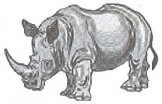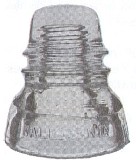THE RHINO
Reprinted from "Crown Jewels of the Wire", March 2003, page 14
Editor's note: A collector who wishes to be called "The Rhino" has
agreed to answer questions sent in by readers. If you want to know more about an
insulator related topic, write Crown Jewels or send an email to: editor@cjow.com

Question: "I have an insulator which says Patented May 2 1893 Hemingray
No 40. But I don't see anything that says CD. Should that be printed on it some
place? I do not understand the CD bit. Thanks."
Rhino's Answer: "CD" stands for "Consolidated Design".
Creating a reference guide based on "consolidated designs" was the
brainchild of N R Woodward many years ago. It is a reference designed for
insulator collectors, and did not exist at the time most insulators were
manufactured. Therefore, you will not find CD numbers embossed on insulators.
Each style, or shape, of insulator has been given a CD number. About 350 CD
numbers have been assigned to threaded, pin-style insulators manufactured in
North America. In some styles, only one company made a particular shape. But
some styles of insulators were manufactured by many companies.
Your Hemingray #40 is one of those styles. The shape is referenced as a CD
152. These were manufactured by a half dozen companies. CD 152's can be found
embossed with the letter "B", the name "Brookfield",
"California" (shown below), with a "diamond", "Hemingray", and "McLaughlin". They are also found embossed only with
numbers: "No 40", "No 48", and with no embossing at all.
The embossing on Hemingray 40's is worded about ten different ways. Overall,
Hemingray 40's are among the most common insulators ever manufactured, and were
used by the hundreds-of-thousands when long-distance telephone lines were being
constructed in the time period ranging from 1915 to 1925. A different shape,
manufactured by Hemingray as the #42 (CD 154) replaced the #40 style by the
mid-1920's.

Hemingray 40's in aqua are worth a buck or less. But they are also found in
more desirable colors: yellow green, olive amber, jade aqua, and milky aqua.
California CD 152's are found in purple, peach, yellow, and two tone purple and
sage green. Among the most valuable CD 152's are the McLaughlin's, of which only
a small number of examples have been found.
The Rhino
| 